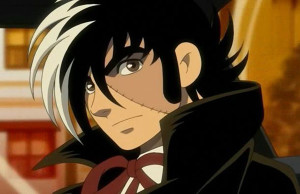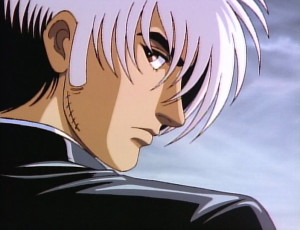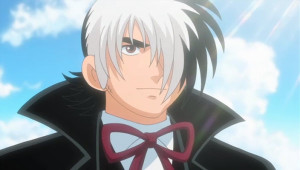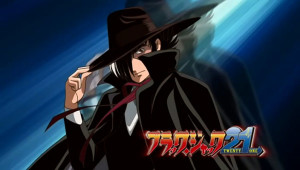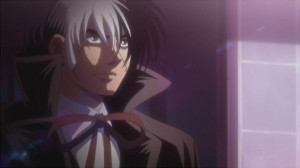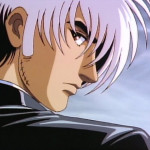Black Jack (Anime)
Also known as ブラック・ジャック (Burakku Jakku)
Tezuka’s rogue doctor, Black Jack, has been featured in several animated series. From his earliest appearances in Tezuka ensemble-cast telefilms, Black Jack has also starred in a series of OAVs, a theatrical movie, a set of ONAs, animated televisions specials, a 61-episode animated television series, a second theatrical movie, another 17-episode television series and a capping set of OAVs.
What it’s about
A charismatic but somewhat sinister surgical genius, Black Jack travels the world performing seemingly impossible feats of surgery – for a price. Although he is almost always able to miraculously save the most gravely ill of patients, even those on the verge of death, his outrageous fees are often more than those who hire him expect. As such, though he and his pint-sized assistant Pinoko, try to live a quite life in his small clinic out in in the deserted country-side, there is a steady stream of patients that other doctors have given up on beating a path to his door. He is their very last hope.
What you should know
Despite being extremely popular from his manga debut in 1973, Black Jack‘s first animated appearances were relatively limited. Given that Tezuka Productions was just getting off the ground, the time was not yet right for an animated television series devoted to Black Jack. Instead, his first foray into animation came as part of an ensemble cast in One Million Year Trip: Bandar Book (1978), Japan’s first 2-hour animated television special. However, despite being cast in this science-fiction adventure as a mysterious and no-nonsense space pirate, he appears in his regular black suit and ribbon bow-tie. This was followed up by an appearance in Undersea Super Train: Marine Express (1979), another Tezuka Star System “cross-over” murder mystery story featuring Black Jack, Astro Boy, Shunsaku Ban, Sapphire, Rock, Dr. Ochanomizu, Duke Red, Sharaku and Don Dracula (among others). Legend has it that, while Osamu Tezuka left his other characters in the hands of other animators, he insisted on drawing each cell of Black Jack personally, and these cells were used as the basis for Black Jack as he appeared in all later animation.
Next up for Black Jack was a small part in Phoenix 2772 (1980), a memorable guest appearance in Episodes 26 & 27 “The Time Machine” of Astro Boy (1980-81), as well as another Star System television special, Bremen 4: Angels in Hell (1981), based on Grimm Brothers fairy tale “The Town Musicians of Bremen” and featuring the Amazing Three, Astro Boy and Don Dracula.
He also appeared as “Kuro” in the very short (approx. 6 minutes in length) pilot film, Brave Fire S-09 (1987). Submitted to a special animation competition held as part of a public relations campaign for a power company, the work was unfortunately not selected for production, although it is easy to understand why. Never missing the opportunity to make a statement, Osamu Tezuka intentionally drafted a science-fiction story about a robot (S-09) that can convert sunlight into clean energy, set in a future where Earth’s natural resources were exhausted – obviously not the message the power company had hoped to convey.
Black Jack would have to wait until 1993, several years after Osamu Tezuka’s death in 1989, to receive his own stand-alone animated series. Produced by Tezuka Productions and the Black Jack Committee, the 10-episode Black Jack Original Video Animation (OVA) series was produced and released from 1993 to 2000, and is largely regarded as the most popular Black Jack animation. Two of the main reasons for this are the character designs by Akio Sugino, and famed director Osamu Dezaki’s use of visual effects such as pastel still images and split screen animations, which show more than one character and their expressions or scenery in one shot at the same time. The series was so popular, in 1996 it inspired a feature film, Black Jack: The Movie, by the same team.
At the turn of the century, Black Jack once again appeared in Tezuka Star System animated special, Osamu Tezuka’s Last Mystery of the 20th Century (2000), a special video “Episode #143” that was released as part of the Japanese Black Jack collectors’ box and was based on the Black Jack manga chapter 143, “The Boy Who Came From The Sky”, as well as possibly the rarest of Black Jack anime – the 35 millimeter reel film, Black Jack: Captial Transfer to Heian (2000). Narrated by the Phoenix, the story is based on Chapter 89 of the manga, “Granny”, and tells the story of strife between an old woman and her daughter-in-law. Since it has never been broadcast on television, it was originally only viewable at the Osamu Tezuka Museum in Takarazuka.
Then in 2001, the Black Jack Original Net Animation (ONA) series was released and was only available via online download with a subscription. Created in Adobe Flash, these twelve 10-minute episodes are, with the exception of “The Boy Who Came From The Sky”, as close as Black Jack animation could possibly get to the manga. Each episode has been faithfully adapted from a single original manga chapter, with no drastic changes to the appearance of the cast or the endings of each episode. While the animation might not be as smooth or as appealing as some other series, given that the series was designed for online streaming, it does have one feature that differentiates is from all other Black Jack series – the ability to zap at specific key points in order to obtain alternative scenes. While most of the episodes have also been animated in later Black Jack series, there are two episodes in the Black Jack ONA (2001) series which have never been adapted in other series.
Although “Episode 143” (2000), Black Jack: Captial Transfer to Heian (2000) and the Black Jack (ONA) (2001) series were originally only available in a limited fashion, all three have subsequently been released online for digital rental.
In 2003 began the first of three interconnected works done by the same creative team. First up was a series of four specials entitled Black Jack: The Four Miracles of Life (2003), which proved popular as a lead in to the 61-episode animated Black Jack (2004-05) television series. A month after it wrapped up, it was subsequently followed by the 17-episode Black Jack 21 (2006) animated television series. Both television series and the specials were produced by Yoimuri TV and aired on Nihon TV, and they were directed by Osamu Tezuka’s son Makoto Tezuka. Despite the fact that each of the three series starts over with its own numbering and has a different opening theme, given that they use the same voice cast, art and animation style, and include flashbacks and references to each other, the three should be considered as a single unit. For the most part, each episode of these three series is very closely based on a specific chapter of the original Black Jack manga. Although the episodes usually maintain all the important parts of the original story, they often include embellishments, such as the presence of ongoing secondary characters, and/or a change to the ending of the original story. One of the main differences between the two television series is that Black Jack 21 (2006) incorporates more of an ongoing continuity.
The original television series was popular enough to lead to another theatrical release, Black Jack: The Two Doctors of Darkness (2005). The animated movie uses the same character designs and overall animation style as the televisions series, albeit with a bigger budget. In theaters the movie was preceded by a seven-minute long short film called Dr. Pinoko’s Forest Adventure (2005), which shows her adventures in the forest helping animals, and contains many familiar animal characters from Tezuka’s works.
In the 2009 OAV Ravex in Tezuka World Black Jack appears as “Space Jack” in another cast full of Tezuka’s Stars. The roughly 20-minute OAV was part of the Limited Edition of the Ravex album Trax, which marks Avex’s 20th anniversary and what would have also been Tezuka’s 80th birthday.
Finally, in May 2011, eleven years after the release of episode 10, Tezuka Productions announced the production of Black Jack FINAL (2011), the final two episodes (11 & 12) of the Black Jack (1993-00) OAV series. Although Akio Sugino returned as the lead character designer, the fact that Osamu Dezaki passed away in April 2011 meant that Satoshi Kuwabara was in charge for episode 11 and Masayoshi Nishida took over for episode 12. Although modeled after the original Black Jack OVA (1993-00) series, including many of Dezaki’s signature elements, Black Jack FINAL (2011) incorporates modern animation techniques and CGI effects.

